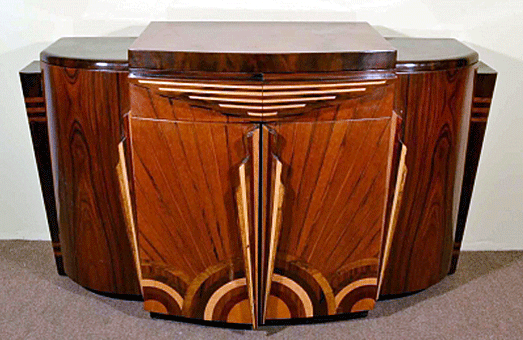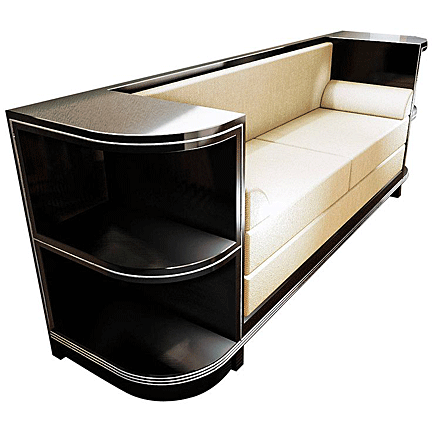|
The Chic Luxury of Art Deco Furniture
by
Bob Brooke
 Consisting
of sleek, rounded corners, streamlined designs, and futuristic styling,
Art Deco had a look of things to come. Seating often curved slightly
inward, suggesting intimacy and sensuousness. Stylized human forms with
elongated shapes were iconic decorative art deco influences used in
statues, lighting and artworks. Consisting
of sleek, rounded corners, streamlined designs, and futuristic styling,
Art Deco had a look of things to come. Seating often curved slightly
inward, suggesting intimacy and sensuousness. Stylized human forms with
elongated shapes were iconic decorative art deco influences used in
statues, lighting and artworks.
Geometric designs often provided design counterpoint to the soft rounded
lines of classic Art Deco furniture. Designers incorporated fan motifs
using layered triangles. Circular designs were common.
They combined metals, chrome, plastics and glass with wood to add
textural elements and reflective embellishments. Finishes were shiny or
glossy. Wood was heavily lacquered or enameled and polished to a high
sheen.
Fabric choices enhanced the feeling of luxury and opulence in Art Deco
furniture. Designers used bold geometric, animal or exaggerated floral
prints in soft, sumptuous materials to contrast and compliment the sleek
styling. Trim details such as tassels and edging were common finishing
touches for overstuffed cushions.

Modular furniture made its first appearance with Art Deco. Separate
pieces with curve edges that fit together became popular. The style was
bold and innovative, but also inviting and comfortable.
Art Deco furnishings frequently used marquetry, enameling and other
techniques to create surface interest. During the 1920's vivid color was
often used. Furniture forms combined sleek curves with angularity.
 In the 1930's the color palette became more subdued with white, black,
and metallic surfaces combined with softer hues. The style came to be
associated with a high technology, futurist view of American culture in
an age when the romance of air travel was at its peak.
In the 1930's the color palette became more subdued with white, black,
and metallic surfaces combined with softer hues. The style came to be
associated with a high technology, futurist view of American culture in
an age when the romance of air travel was at its peak.
The 1930s saw radical changes in furniture design. The Art Deco style,
which had reached its peak at the 1925 Exposition, gradually waned. Its
decorative flourishes and emphasis on rich and exotic materials seemed
increasingly irrelevant, particularly in light of the Great Depression.
At the same time, the geometric forms and plain undecorated surfaces
concurrently favored by the International Style modernists, such as Le
Corbusier or designers of the German Bauhaus, proved too demanding for
most people.
Gone, too, was the conventional approach to furnishings as expensive and
permanent status objects. New materials and technologies, many of which
had been developed during wartime, helped to free design from tradition,
allowing for increasingly abstract and sculptural aesthetics as well as
lower prices for mass-produced objects.

 French
Art Deco featured luxurious furniture handcrafted out of sumptuous and
exotic materials. This cabinet references traditional forms of French
furniture, but is inlaid with ivory, a reference to (and product of) the
elephants of exotic Africa, where France had important colonies. The
inlay forms a Classical urn holding cut flowers — again it's stylized
and tamed nature as opposed to the rampant vines of the Art Nouveau era.
Like much Art Deco furniture, this is low to the ground, with
attenuated, elegant lines. French
Art Deco featured luxurious furniture handcrafted out of sumptuous and
exotic materials. This cabinet references traditional forms of French
furniture, but is inlaid with ivory, a reference to (and product of) the
elephants of exotic Africa, where France had important colonies. The
inlay forms a Classical urn holding cut flowers — again it's stylized
and tamed nature as opposed to the rampant vines of the Art Nouveau era.
Like much Art Deco furniture, this is low to the ground, with
attenuated, elegant lines.
After the 1925 Paris Exposition, American designers began working in the
Art Deco style. For American audiences, however, there was less of an
emphasis on luxury and exclusivity and more interest in mass-production,
accessibility, and the machine age. The products of American Art Deco
had a more industrial, machine-age feel than their French counterparts.
American Art Deco
American Art Deco was preoccupied by speed, a symbol of modern
transportation. By the 1930s, it had become dominated by the Streamline
Style, which used things like visual simplicity and automotive styling
to represent speed and modernity.
 The
heroes of American Art Deco were the industrial designers, heavily
influenced by the German Bauhaus School, and Paul Frankl was their
undisputed leader. He created the Skyscraper line of furniture, which
used motifs and echoes from New York's famous buildings. The
heroes of American Art Deco were the industrial designers, heavily
influenced by the German Bauhaus School, and Paul Frankl was their
undisputed leader. He created the Skyscraper line of furniture, which
used motifs and echoes from New York's famous buildings.
Large manufacturers and department stores helped promote this
Streamlined Style to the public. The designers, meanwhile, employed it
for everything from overstuffed armchairs and sofas to kitchen and
bedroom furnishings.
The Essence of Art Deco Design
 Designers
during the Art Deco era used bold geometric shapes based on traditional
forms— essentially simplified geometric ornamentation. They used pine or
maple woods for less expensive painted or lacquered pieces and walnut,
mahogany or other exotic woods for finer examples. Occasionally, they
incorporated glass and metal, namely chrome, into their furniture
designs. Designers
during the Art Deco era used bold geometric shapes based on traditional
forms— essentially simplified geometric ornamentation. They used pine or
maple woods for less expensive painted or lacquered pieces and walnut,
mahogany or other exotic woods for finer examples. Occasionally, they
incorporated glass and metal, namely chrome, into their furniture
designs.
Popular forms included the overstuffed armchair, sofa, and ottoman.
Dining room and kitchen sets, as well as side, coffee, and end tables.
One new form, the coffee, or cocktail, table, was usually lacquered or
topped by blue mirrored glass, a distinctively American type of
decoration.
 Just
because they were simplified and stylized, however, doesn't mean that
Art Deco pieces were plain or Spartan. Its practitioners were not
form-follows-function guys (in fact, some of the furniture designed by
architect Frank Lloyd Wright was notoriously unfunctional). Art Deco
designers were all for ornamentation - just a different, more restrained
kind of ornamentation. Just
because they were simplified and stylized, however, doesn't mean that
Art Deco pieces were plain or Spartan. Its practitioners were not
form-follows-function guys (in fact, some of the furniture designed by
architect Frank Lloyd Wright was notoriously unfunctional). Art Deco
designers were all for ornamentation - just a different, more restrained
kind of ornamentation.
With Art Deco, the texture and embellishment came from contrasts in the
materials - variously colored woods and inlays - or in the material
itself: burled or birds-eye or visibly grained woods, tortoise shell,
ivory, tooled leathers. Lacquered glosses accentuated color differences.
Animal skins and patterned fabrics in bright colors were popular, too.
Like the Jazz Era in which it thrived, Art Deco furniture conveys a
sense of dash and lightness.
The Emergence of Art Moderne
 While
decorative arts experts apply the term Art Deco to furniture from the
1920s through the 1940s, so do they use the term Art Moderne.
Understanding the difference between the two isn't always easy,
especially since people called Art Deco “Moderne” at the time. Today,
antiques dealers refer to much of what's actually Moderne as Art Deco. While
decorative arts experts apply the term Art Deco to furniture from the
1920s through the 1940s, so do they use the term Art Moderne.
Understanding the difference between the two isn't always easy,
especially since people called Art Deco “Moderne” at the time. Today,
antiques dealers refer to much of what's actually Moderne as Art Deco.
The furniture is much more pared or stripped down, making all the more
prominent its geometric outline, especially like a tear drop or torpedo.
Moderne designers often conceived pieces as a series of escalating
levels, similar to a staircase or the setback effect of skyscrapers.
Designers created Moderne furniture to be mass-produced, but even if it
wasn't, it looked as if it could be. Much of the decorative interest in
a Moderne piece comes from the precision of line and duplication of
functional features—handles, knobs, bolts. Otherwise, surfaces are often
plain, with even less detail than in Art Deco pieces. Instead, Moderne
furniture often conveys a sense of motion, as in a table's tiered
levels, or the jutting thrust of a club chair's arms.
Though light and uncluttered, Moderne pieces never seem skimpy, thanks
to the sensuality of their rounded, curvaceous forms. As in Art Deco
furniture, big use is made of color contrasts, especially black and
white, and contrasting materials - not just to different woods, but
chrome, metal and plastics. Slick, shiny surfaces continue to
predominate, giving furniture the gloss of a new machine.
<
Back to Antiques Archives
Next Article >
|
